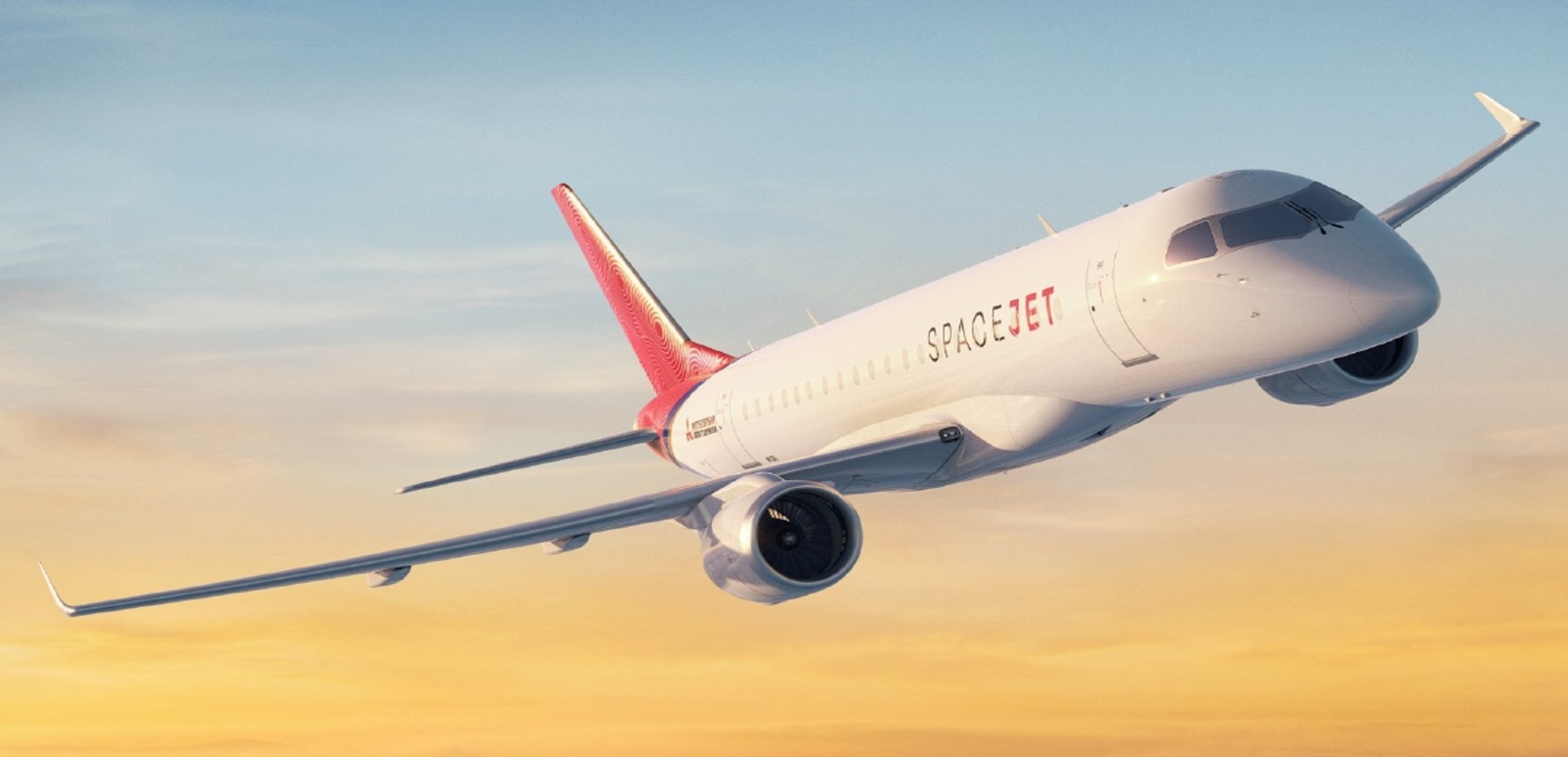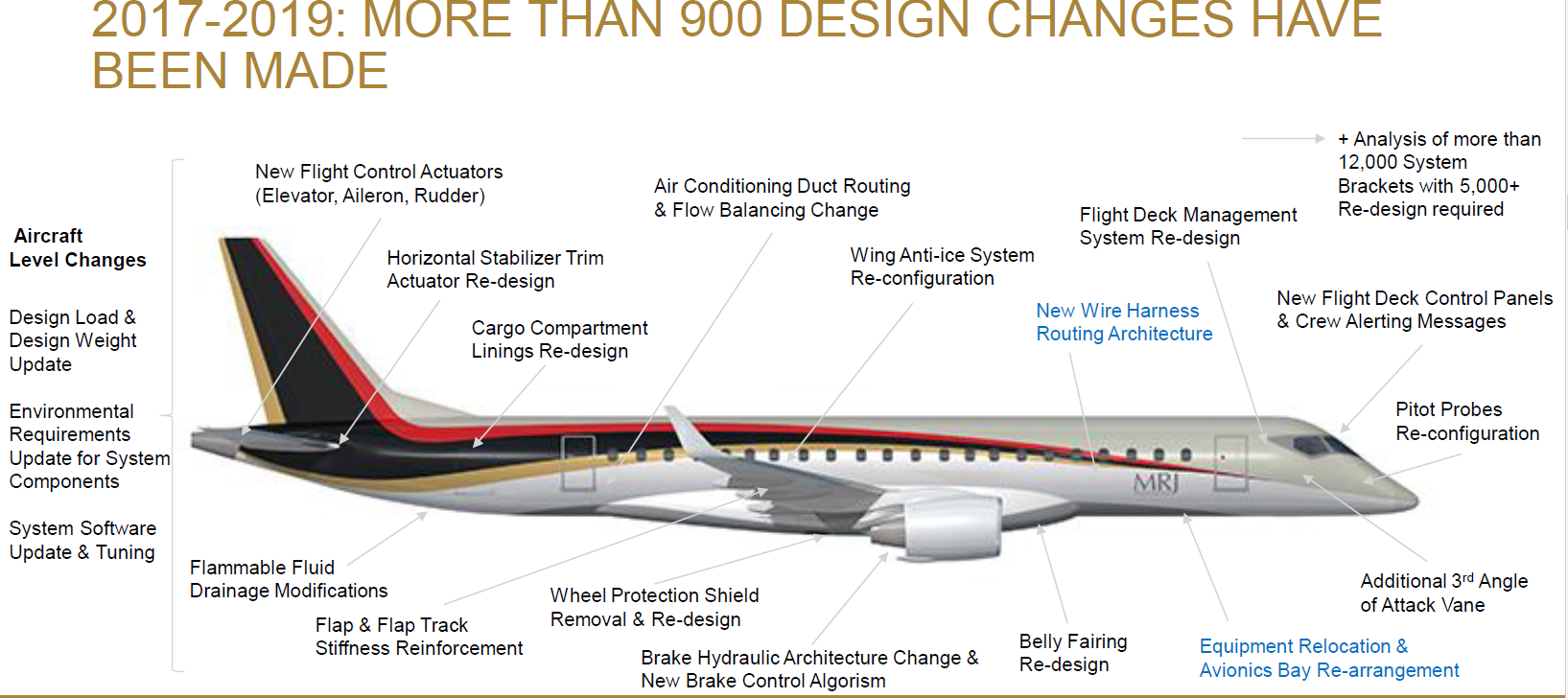Leeham News and Analysis
There's more to real news than a news release.
Surrounded by global bad news, Mitsubishi launches new SpaceJet testing
By Scott Hamilton
March 18, 2020, © Leeham News: While stock markets implode the world over and stock of Boeing, Airbus and Embraer take their own dives, Mitsubishi Aircraft Corp. (MITAC) was a rare piece of good news.
Flight Test Vehicle 10, an M90 Spacejet regional airliner, took off yesterday on its first flight in Japan.
Redesigned airplane
FTV10 is the first of a drastically revised MRJ90. The M90 has more than 900 changes compared with the MRJ90, Japan’s first commercial airliner since the YS-11 in 1962.
Design of the MRJ90 fell short of certification standards and other shortcomings. Several MRJ FTVs were produced before many of the shortcomings were discovered.
In a major effort that added to several delays in the program, MITAC redesigned the MRJ90 and rebranded it as the M90 SpaceJet. Simultaneously, MITAC launched the M100 SpaceJet, a smaller version that complies with current restrictions of the US Scope Clause in pilot labor contracts. The MRJ90 and M90 exceed the weight limits.
Japan’s ANA and JAL are launch customers of the MRJ90. They will receive the M90 instead, in 2021 or 2022—8-9 years after the planned EIS of the MRJ. The M100, designed principally for the US market, has a target EIS of 2024 or 2025.
FTV10 was airborne for nearly two hours. The airplane will be ferried to Washington State, where most of the flight testing is done.



That is good news.
There is a future and companies should keep that as front and center along with managing the current situation.
Isn’t there a ten year window between application for type certificate and award of type certificate, after which the process must restart using current regulations? Where do these models stand relative to that timeframe?
It is actually closer to 5 years. But yes upon submission of Certification Basis paperwork for a new type certificate or amended type certificate application there is a clock ticking to have TC/ATC granted based on the filed certification basis.
The number of and seriousness of the design changes for me raise questions on the original design.
The original test pilots were lucky to have survived first flight?
Well they did … the risk is extremely low for the few non compliant areas. ( for the limited duration test period)
Prototype crashes are usually connected to pilot error rather than some failing of the airliner.
Remember, even with the far looser certification standards of the
1960s and before , which jet airliner prototype crashed during testing ?
The Trident 1C crash that was related to the T tail configuration may have been the only one.
You may have heard even the 737 Max wiring is non compliant in a few areas, but that hadnt caused any crashes.
Duke: Well put!
Actually the wiring on the 737 is also NG, they just found it on MAX review (along with a few other pesky things)
I say the heck with it, accept produced MAX as is and don’t mess with the wring. Old mechanic say9ing, if it aint ‘ broke don’t fix it (yes that can be taken too far)
I worked around a lot of aircraft mechanics and their worse nightmare was a plane just out of a heavy check. All those little things that were not quite right or disturbed. I know you have to do them but someone should do a study on the hazards as well to put it in perspective.
Have them correct on any new production units where you don’t disturb a bunch of stuff.
Remember the Ethiopian 787 fire? Wire clamped in between the housing and shorted.
“Additional 3rd angle of attack vane.” would this have been an FAA mandated modifications arising from the pre 2017 review?
Being years late to EIS, I don’t think the MRJ series will be a major player. Disappointed with Mitsubishi in poor planning, settling on a final design and over promising and under delivering.
I always felt the Japanese companies were conservative in planning and production, seems like Mitsubishi has joined the rest of the world where the sales teams set the standards.
Nearly 900 CRJ 700 series alone built ( 700/900/1000). Another 800 E170/175 built.
Easily the total market is say 1500 of existing planes for the 70-85seaters. Another 800 E190s built
Spacejet has a weight advantage over the E jets due to its single bubble even with modern GTF engines. Mitac now owns the CRJ support and sales business.
Very good chance to have the lions share of this market now that Embraer is back to being an orphan, as no chance of Boeing getting nearly $5 bill to invest in another countrys manufacturer.
They were only making the first step in being a major player, Spacejet is just the start for Japan doing an Airbus.
Can you spell SCOPE CLAUSE?
I know it’s not important for 2000nm range but why is its speed only M0.78 / 447kn?
M90 suffered a long delay and today it’s another missed chance for turboprops.
Stupid to be fan crazy, C919 and MR-21 LOL
Embraer might do the homerun and beat everything else.
0.78 Mach is the cruise speed of both the E-jet and CRJ.
Think MITAC learned the trade and had cash to survive all the delays, a bit similar to the HondaJet. These first models might be good but the following models might be excellent and very competetive if they continue to invest. It can be like the car market where Japan started with small cars and grew in size to be very competetive. The MITAC Shell is one thing but do Japanese supplier do the expensive boxes and accessories with software like on the cars or are they fully stuffed with Honeywell, Collins, Thales and Liebherr Components?
Embraer doesnt even do the shell or wing on its E series as it uses global suppliers for sub systems and air frame sections, except it does the cockpit section. Wing skins and rear fuselage sections come from Triumph and forward fuselage section from Kawasaki in Japan.
Likely that Japan will be doing more of the Spacejet in country than Embraer does for its E series.
Since 2000 Japan has put into service the military P-1 which is the size of the 737 and the C-2 which is a bit smaller than the A400M. All large airframe military jets, so a further step in the civilian area likely.
Yes, most likely will there be a bigger Honda Jet, a bigger Mitsubishi (like C-series competitor), a new Japanese 2 engine stealth fighter (mix of F-22 and F-23) with IHI engines, so they are moving closer and closer.
But one thing is to make them look good and work at high costs with some help (Mitsubishi F-2), next step is to make them durable, profitable and give great service to its global customers (the pure military suppliers usually have problems taking this step)
Yes, but the CAD models and drawings with tolerances as a result of aero, stress and controls analysis together with manufacturing tolerances and mass requirements has been developped by Embraer, then it is up to purchasing to find the cheapest global supplier that can meet all requirements every time often boosted with money from its gouverment.
Yes. The prime contractor takes all the risk during development and the marketing. Embraer was attractive to Boeing as it was already the ‘systems integrator’ the Boeing wanted to be when they did the 787, but Embraer and its suppliers were competent in existing technologies and didnt do cutting edge.
For the certification phase Embraer had an existing range of civilian planes they had experience with before making the step up with the E series and of course they did their larger military airlifter after the airliner not before.
But just goes to show , you cant stand still as you lose all the competencies.
Scott,
Would you please check with your sources for the answers to the questions in my prior post. Thanks.
My vague memory is that aircraft are certificated to FAR 25 Through Amendment XX. This keeps everyone from chasing a moving target during the development process while the clock is ticking.
Mitsubishi just replaced the directors involved with the aircraft development
‘in order to double down on the certification process’ (today’s Flightglobal) so there must be something to this ticking clock thing.
Ron: Japanese JABC is on board. Things are progressing slowly, inhibited by the negative halo effect of the MAX-FAA debacle. Most of the changes mentioned in Flight are changes done annually in Japanese companies, Mitsubishi included.
This was interesting in Europe MAX flight.
https://simpleflying.com/smartwings-operates-2-hour-boeing-737-max-flight-over-prague/
@Dukeofurl
I believe you are refering to the BAC111 prototype and not the DH Trident.
Thanks, the BAC111 was earlier of course but the Trident 1C crashed for the same reasons in 1966 during stalling tests, probably pilot error.
https://aviation-safety.net/database/record.php?id=19660603-1
Another Trident had a very hard landing a year later
Airbus A330 crashed on a test flight testing its auto pilot
https://aviation-safety.net/database/record.php?id=19940630-0